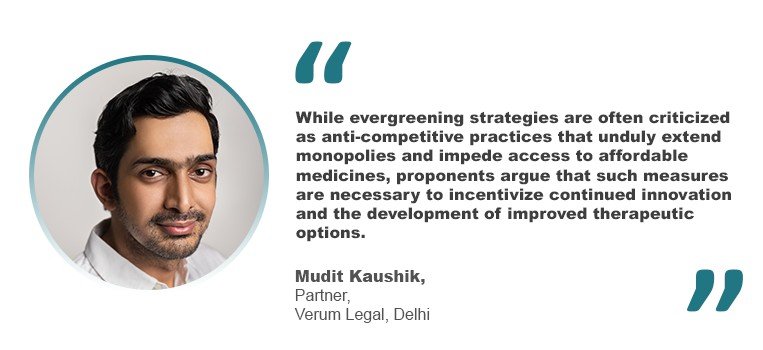What is patent evergreening?
27 September 2024

The evergreening of patents, while maximizing commercial value and delaying generic competition, raises ethical and legal concerns about its impact on drug affordability and public health. Excel V. Dyquiangco explores the controversial practice of evergreening in the pharmaceutical industry and the debates about whether evergreening stifles genuine innovation and inflates healthcare costs.
In recent years, numerous studies have exposed a concerning trend in the pharmaceutical industry. Using strategies to extend patent and regulatory protection for their drugs, companies implement practices that often involve minor tweaks to existing medications, raising questions about their true value. This is achieved through various means, including obtaining new patents on different aspects of the same drug, such as its formulation, new forms of release, new dosages, new combinations, variations or new forms, method of administration or even its therapeutic use in different conditions. The industry calls it “lifecycle management” or, in some cases, “evergreening.”
As the debate over evergreening intensifies, critical questions emerge about the nature and impact of these practices. Are these modifications innovative enough to warrant the lucrative “golden patents” they secure? Is the current system encouraging companies to spend resources on minor tweaks instead of focusing on truly groundbreaking discoveries? And ultimately, how can the industry reform the patent system to strike a balance between rewarding innovation and ensuring access to affordable medications?
According to Mudit Kaushik, an advocate at the Delhi High Court and a partner at Verum Legal in Delhi, the significance of evergreening for pharmaceutical companies lies in its potential to maximize the commercial value of their patented inventions.
“By strategically layering subsequent patents around an original drug compound, companies can effectively prolong their exclusive market position and delay the entry of generic competitors, thereby maintaining their revenue streams and recouping the substantial investments made in research and development,” he said.

He added: “While evergreening strategies are often criticized as anti-competitive practices that unduly extend monopolies and impede access to affordable medicines, proponents argue that such measures are necessary to incentivize continued innovation and the development of improved therapeutic options.
From a legal standpoint, evergreening practices are permissible as long as the additional patents meet the requisite criteria for patentability, such as novelty, non-obviousness and utility, and do not constitute patent misuse or abuse.”
The impact to public health
Given this scenario, according to Rachna Bakhru, a partner at RNA Technology and IP Attorneys in Gurugram, evergreening does lead to inflated healthcare costs and limits the availability of lower-cost generic alternatives. This is particularly felt in developing countries, where access to essential medicines is critical.

“Moreover, this practice establishes private monopolies that abuse the patent system, negatively impacting vulnerable groups of the population who cannot afford necessary medications,” she added. “It also prevents the market from receiving cheaper, generic versions of medicines, further exacerbating the situation.” Drug prices can remain artificially high by preventing generic competition, she said.
According to Bakhru, generic medicines are “essentially the same as the original branded drugs in terms of efficacy, quality and safety.” Their affordability expands access to a broader population, particularly those with financial constraints, thus ensuring access to essential medications.
“By prolonging the patent protection term, the arrival of generic versions of the medicine is hindered or delayed. This keeps the patients away from affordable access to life-saving medicines, a situation that can be life-threatening and should be a cause for immediate concern,” she explained. “Overall, in terms of public health, the strategy of ‘evergreening’ can be detrimental. This practice essentially blocks affordable generic alternatives, leaving some consumers unable to afford expensive drugs and treatments. This is because the patent duration prevents manufacturers from producing more affordable generic versions of branded drugs,” she said.
Kaushik noted that with evergreening, there is also limited access to improved formulations. “While proponents of evergreening argue that it incentivizes the development of improved drug formulations or delivery systems, critics argue that these improvements are often minor and do not necessarily translate into significant therapeutic advantages. In some cases, the new formulations may be more expensive or less accessible, further exacerbating access issues for patients in need of essential medicines,” he said.
He pointed out that there is also a potential for anticompetitive practices. “Some evergreening tactics, such as obtaining patents on minor modifications or pursuing excessive litigation against generic manufacturers, have been criticized as anti-competitive practices aimed at maintaining monopolies rather than promoting genuine innovation. These practices can stifle competition and limit patient choices, potentially compromising public health objectives,” he said.
He emphasized that the impact of evergreening on public health and access to essential medicines may differ based on various factors, such as the regulatory frameworks and healthcare systems in different countries or regions.
Addressing this issue
To address the issue of evergreening and promote access to affordable medicines, Bakhru said that the primary legal mechanism used in India is the Patents Act of 1970, which underwent significant amendments in 2005 to comply with the Agreement on Trade-Related Aspects of Intellectual Property Rights (TRIPS) under the World Trade Organization (WTO).
She added that to combat the unethical practice of patent evergreening and exploitation of patent rights, India also implemented the new patentability criteria in 2005. The Indian Patent (Amendment) Act, 2005 introduced a provision to prevent patent evergreening. The amendment introduced the provision for patents concerning pharmaceutical products in India.
She said: “The concept of evergreening has not found an explicit place under the Indian Patents Act 1970. One such unique provision is section 3(d), which requires the innovator company to prove enhanced efficacy from the previously known substance. However, Section 3 of the act deals with non-patentable substances or products. Section 3(d) of the act states: ‘The mere discovery of a new form of a known substance or mere discovery of any new property or new use for a known substance or of the mere use of a known process, machine or apparatus unless such known process results in a new product or employs at least one new reactant.’ This provision directs towards the prohibition of evergreening of the products for patents.”
The primary objective of patent act provisions is to ensure that patentees not only enjoy monopoly rights but that the awarded patents also serve some social and economic purpose for the benefit of people and maintain the equilibrium of rights. Some key provisions of the Patents Act of 1970 and subsequent amendments include:
- Section 3(d): This provision addresses evergreening by setting a higher standard for the patentability of pharmaceuticals. It states that new known substances can only be patented if they demonstrate significantly enhanced efficacy over existing compounds. This provision aims to prevent the grant of patents for minor modifications or variations of existing drugs, thereby discouraging evergreening.
- Compulsory Licensing Sections 84 and 92: The Patents Act allows for the issuance of compulsory licenses, which permit generic manufacturers to produce patented drugs without the consent of the patent holder under certain conditions, such as public health emergencies or failure to meet the reasonable requirements of the public at a reasonable price.
- Pre-Grant Opposition Section 25(1): The act provides a mechanism for pre-grant opposition, allowing third parties to challenge the grant of a patent during the application process. This provides for scrutiny of patent applications and helps prevent the grant of patents for trivial modifications or evergreening strategies.
- Post-Grant Opposition Section 25(2): Like pre-grant opposition, post-grant opposition allows interested parties to challenge the validity of a patent after it has been granted. This further safeguards against evergreening by enabling the revocation of patents that do not meet the criteria of novelty, non-obviousness and industrial applicability.
“Effectiveness of said laws highlights, particularly in a landmark ruling by the Supreme Court of India in Novartis v. Union of India that rejected a patent application by the Swiss pharmaceutical giant Novartis,” said Bakhru. “The company sought a patent for an updated version of its cancer drug Glivec (imatinib mesylate), contending that the new formulation exhibited improved absorption into the bloodstream, a critical factor in treating leukemia. In the Novartis case, denying a patent for Glivec under Section 3(d) of the Patents Act highlighted the stringent criteria outlined in India’s patent legislation. This decision was grounded in the requirement outlined in Section 2(1)(a), which mandates that a product must exhibit a technical improvement over its predecessor that is not apparent to a person of ordinary skill. Glivec, a modified version of imatinib, failed to meet this criterion.”
Glivec is sold in some markets as Gleevec.
Additionally, Section 3(e) of the Patents Act sets clear guidelines for patenting mixtures of well-known compounds, permitting such patents only if a synergistic effect is demonstrated. In the context of Glivec, this provision played a pivotal role in rejecting the patent application.
“The Indian Patents Act firmly opposes the ever-greening of patents, and court rulings in India support this position,” she said. “The Novartis case verdict clearly illustrates how the courts always put the needs of the people first and give them priority above all other considerations, even when those considerations include the monopolistic actions of the largest market participants.”
She added: “Furthermore, Section 3(i) reinforces the principle that exclusivity over treatment modalities cannot be claimed, emphasizing the legislative intent to prevent the granting of patents for treatment methods and ensuring that advancements in healthcare remain accessible and available for the greater good. These provisions collectively underscore the careful balance between encouraging innovation and safeguarding public interest within the Indian patent system. This legal stance exemplifies India’s proactive approach to addressing concerns related to pharmaceutical evergreening practices.”
While promoting innovation
Kaushik said that to address the issue of evergreening while promoting pharmaceutical innovation, enhancing patent examination procedures is crucial. “Implementing stringent patentability criteria that enforce rigorous standards for novelty, non-obviousness and significant enhancements in therapeutic efficacy can help prevent the granting of patents for minor modifications or reformulations of existing drugs. Additionally, strengthening pre-grant and post-grant opposition mechanisms allows stakeholders to challenge weak patents, ensuring that only genuinely innovative drugs receive patent protection,” he said.
He added: “Promoting transparency and accountability in the patent system is another important strategy. Requiring full disclosure of all related patents and patent applications can help track evergreening practices, while regular audits and reviews of granted patents ensure compliance with stringent standards. These measures prevent the extension of patent monopolies through incremental changes, maintaining the balance between protecting intellectual property and ensuring access to affordable medicines.”
He also emphasized the importance of balancing intellectual property protection with public health interests. Strengthening provisions for compulsory licensing allows generic manufacturers to produce and sell affordable life-saving drugs under certain conditions, such as national emergencies or anti-competitive behaviour cases. He suggested offering alternative incentives for genuine pharmaceutical innovation, such as tax breaks, grants or milestone-based rewards for new drugs, to “encourage meaningful advancements without relying solely on extended patent protection. These strategies collectively aim to meet public health needs while fostering a conducive environment for true innovation in the pharmaceutical industry.”
IP lawyers can also advocate for policies promoting both innovation and equitable access to essential medicines by actively participating in the development and reform of patent laws. Kaushik said that they can work with lawmakers to implement stringent criteria for patentability, ensuring that patents are granted only for genuinely innovative drugs. “By advocating for stricter requirements for novelty and non-obviousness, IP lawyers can help prevent the extension of patent monopolies through minor modifications, thus curbing evergreening practices that limit access to affordable medicines,” he said.
Another critical strategy is to champion alternative incentive models that decouple drug development costs from final product prices. “IP lawyers can promote the adoption of public-private partnerships, prize funds and milestone-based rewards to provide financial incentives for pharmaceutical innovation without relying solely on patent exclusivity. These alternative models can address concerns about excessive drug pricing and ensure that essential medicines remain accessible while still encouraging robust research and development efforts,” he said.
Enhancing transparency and enforcing antitrust regulations are also vital areas where IP lawyers can make a significant impact. By advocating for policies that require full disclosure of all related patents and patent applications, they can help track and prevent evergreening practices. Additionally, supporting stronger antitrust enforcement against practices like pay-for-delay agreements that delay the entry of generic drugs into the market can promote competition. Through these efforts, IP lawyers can contribute to a balanced framework promoting both innovation and equitable access to essential medicines.






